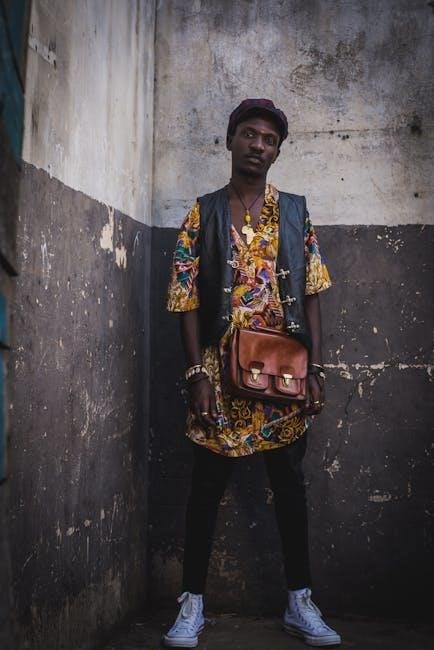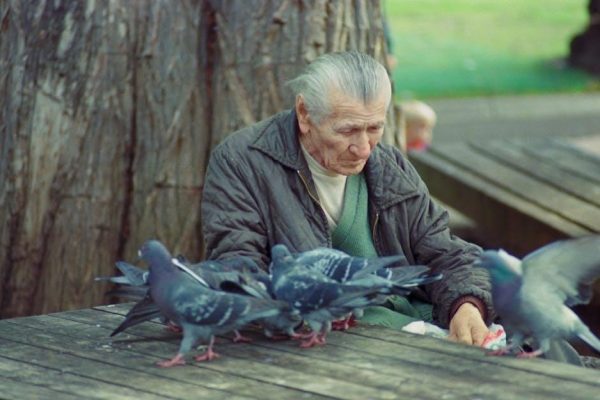Rudolfo Anaya’s Bless Me‚ Ultima (1972) is a seminal work in Chicano literature‚ exploring themes of identity‚ faith‚ and cultural heritage through Antonio Márez’s journey. The novel‚ set in 1940s New Mexico‚ follows Antonio’s spiritual awakening under the guidance of Ultima‚ a wise curandera. This coming-of-age story weaves together rich cultural elements‚ magical realism‚ and profound introspection‚ making it a cornerstone of American literature. Available as a PDF‚ the novel and its study guides offer insights into its enduring themes and symbolic depth.
1.1 Overview of the Novel
Bless Me‚ Ultima‚ written by Rudolfo Anaya‚ is a captivating coming-of-age novel set in 1940s New Mexico. The story revolves around Antonio Márez‚ a young Chicano boy‚ and his spiritual journey under the guidance of Ultima‚ a wise and powerful curandera. The novel explores themes of cultural identity‚ faith‚ and the clash between tradition and modernity. Through Antonio’s experiences‚ Anaya weaves a rich tapestry of Hispanic culture‚ blending elements of mysticism and realism. The novel is widely regarded for its vivid storytelling and profound exploration of existential questions. Available as a PDF‚ Bless Me‚ Ultima remains a vital text in Chicano literature‚ offering insights into the struggles and triumphs of a young boy navigating his heritage and destiny.
1.2 Background and Setting
Bless Me‚ Ultima is set in the 1940s in the rural landscapes of New Mexico‚ a region deeply rooted in Hispanic culture and tradition. The story unfolds in a small village on the plains‚ where the Márez family resides. The setting reflects the blending of indigenous‚ Spanish‚ and Mexican influences‚ creating a unique cultural tapestry. The vast‚ open llano and the nearby river serve as symbolic backdrops‚ representing freedom and spirituality. The post-World War II era adds a layer of change‚ as modernity begins to encroach on traditional ways of life. This clash between old and new is central to Antonio’s journey‚ as he navigates his identity amidst the rich cultural and historical context of his surroundings.

Author Background: Rudolfo Anaya
Rudolfo Anaya‚ born in 1937 and passing in 2020‚ is a pivotal figure in Chicano literature‚ blending folklore with contemporary issues in works like Bless Me‚ Ultima‚ influencing cultural and educational discourse.
2.1 Biography of Rudolfo Anaya
Rudolfo Anaya was born on October 19‚ 1937‚ in Pastura‚ New Mexico‚ to a family of Hispanic farmers. His upbringing in a bilingual‚ bicultural environment deeply influenced his writing. Anaya earned a Bachelor of Arts in English from the University of New Mexico in 1963 and later a Master of Arts in 1968. Before becoming a full-time writer‚ he worked as a public school teacher and later as a professor at the University of New Mexico. His experiences as a Chicano shaped his literary focus on cultural identity‚ spirituality‚ and the blending of traditions. Anaya is best known for Bless Me‚ Ultima‚ which launched his career and remains a cornerstone of Chicano literature.
2.2 Anaya’s Literary Contributions
Rudolfo Anaya is a pivotal figure in Chicano literature‚ celebrated for his rich‚ evocative storytelling and exploration of cultural identity. His novel Bless Me‚ Ultima is a landmark work‚ offering a profound portrayal of Chicano experiences‚ spirituality‚ and the blending of traditions. Anaya’s writing often incorporates elements of magical realism‚ folklore‚ and historical context‚ creating a unique narrative style. His contributions extend beyond Bless Me‚ Ultima‚ with notable works like Heart of Aztlan and Tortuga‚ which further explore themes of identity and resilience. Anaya’s influence is also seen in his essays and children’s books‚ which highlight the importance of preserving cultural heritage. His work has been adapted into films and study guides‚ ensuring its enduring impact on American literature.

Plot Overview
Bless Me‚ Ultima follows Antonio Márez‚ a young Chicano boy‚ as he navigates cultural identity‚ spirituality‚ and coming-of-age challenges in 1940s New Mexico‚ guided by Ultima.
3.1 Key Events in the Novel
Bless Me‚ Ultima unfolds through pivotal events shaping Antonio’s journey. Ultima’s arrival marks the beginning of his spiritual education‚ teaching him about herbs and life’s mysteries. Antonio witnesses Ultima’s healing powers‚ such as curing his uncle‚ and grapples with her reputation as a healer. The death of Lupito‚ a town outcast‚ sparks Antonio’s moral dilemmas. The golden carp’s legend introduces mystical elements‚ challenging Antonio’s Catholic faith. His First Communion becomes a crisis of belief. Ultima’s death symbolizes the end of an era‚ leaving Antonio to reconcile his cultural and spiritual identity. These events collectively guide Antonio toward self-discovery and understanding of his dual heritage.
3.2 Chapter Summaries
Bless Me‚ Ultima is divided into 22 chapters‚ each offering a snapshot of Antonio’s maturation and the world around him. The novel begins with Ultima’s arrival‚ marking the start of Antonio’s spiritual and cultural awakening. Chapters explore his conflicts between faith and reason‚ highlighted by his First Communion dilemma. The golden carp’s legend introduces mystical elements‚ challenging Antonio’s Catholic beliefs. Key chapters focus on Ultima’s wisdom‚ her healing practices‚ and the tragic events‚ such as Lupito’s death‚ that shape Antonio’s understanding of morality. Each chapter builds upon the last‚ weaving together themes of identity‚ tradition‚ and spirituality‚ ultimately leading to Antonio’s acceptance of his dual identity and the loss of Ultima‚ symbolizing the end of an era.

Main Themes
Bless Me‚ Ultima explores cultural identity‚ faith‚ and coming of age‚ delving into Antonio’s struggles with spirituality and tradition. Themes of morality‚ family‚ and heritage are central.
4.1 Cultural Identity
Cultural identity is a central theme in Bless Me‚ Ultima‚ as Antonio Márez navigates his heritage as a Chicano in New Mexico. The novel portrays the blending of Indigenous‚ Spanish‚ and Mexican influences‚ reflecting Antonio’s internal conflict between his father’s nomadic vaquero traditions and his mother’s rooted farming culture. Ultima serves as a symbol of cultural preservation‚ teaching Antonio about traditional healing and spirituality. The PDF study guides highlight how Antonio’s journey mirrors the broader Chicano experience‚ emphasizing the struggle to reconcile multiple cultural identities within a changing world. This theme resonates deeply‚ offering insights into the complexities of cultural belonging.
4.2 Faith and Spirituality
Faith and spirituality are deeply intertwined in Bless Me‚ Ultima‚ as Antonio grapples with Catholicism and the mystical beliefs of his community. Ultima‚ a curandera‚ embodies a blend of Indigenous and Catholic traditions‚ offering Antonio spiritual guidance that contrasts with the rigid doctrines of the church. The novel explores Antonio’s internal conflict between organized religion and the natural‚ earth-based spirituality Ultima represents. The PDF study guides emphasize how Antonio’s questions about faith reflect a broader struggle to reconcile tradition with personal belief. The Golden Carp‚ a symbol of pre-Christian spirituality‚ further complicates Antonio’s understanding of divine truth. Through these elements‚ Anaya examines the tension between institutional faith and individual spiritual journeys‚ enriching Antonio’s coming-of-age narrative.
4.3 Coming of Age
The coming-of-age theme in Bless Me‚ Ultima is central to Antonio’s development‚ as he transitions from childhood innocence to adolescent awareness. The novel‚ available as a PDF‚ portrays Antonio’s journey through pivotal experiences‚ including Ultima’s teachings‚ the death of Lupito‚ and his questioning of faith. Study guides highlight how these events force Antonio to confront moral dilemmas‚ cultural expectations‚ and his own identity. Ultima serves as a mentor‚ guiding him toward self-discovery and resilience. The novel’s exploration of Antonio’s growth underscores the universal challenges of adolescence‚ making his story relatable and profound. Through his experiences‚ Anaya illustrates the struggle to balance tradition with personal growth‚ shaping Antonio’s path toward maturity.
4.4 Tradition vs. Modernity
In Bless Me‚ Ultima‚ the tension between tradition and modernity is a recurring theme‚ particularly through Antonio’s experiences. The novel‚ available as a PDF‚ explores the clash between the old-world beliefs of Antonio’s family and the encroaching modernity of the outside world. Ultima‚ as a symbol of tradition‚ embodies the spiritual and cultural practices of Antonio’s heritage‚ while events like the golden carp legend and the influence of formal education challenge these traditions. Antonio’s struggle to reconcile these forces reflects the broader cultural shifts of 1940s New Mexico. Study guides highlight how Anaya uses these contrasts to examine identity‚ change‚ and the enduring power of cultural roots in a rapidly evolving world.

Symbols in the Novel
Central symbols in Bless Me‚ Ultima include the golden carp‚ representing cultural and religious duality‚ and Ultima‚ embodying wisdom and spirituality. PDF study guides offer detailed analysis of these motifs‚ enhancing understanding of Anaya’s rich symbolism.
5.1 The Golden Carp
The golden carp is a pivotal symbol in Bless Me‚ Ultima‚ representing cultural and religious duality. It appears in Antonio’s dreams‚ embodying the clash between Indigenous beliefs and Christianity. The carp’s divine status in local folklore contrasts with the Catholic faith Antonio is raised in‚ reflecting his internal conflict. PDF study guides highlight how the carp symbolizes the enduring presence of Indigenous traditions in a rapidly changing world. Its significance is deeply tied to Antonio’s spiritual journey‚ as it challenges his understanding of faith and identity. The carp’s presence in the novel underscores themes of cultural preservation and the blending of spiritual traditions‚ making it a powerful motif in Anaya’s exploration of Chicano identity.
5.2 Other Significant Symbols
Beyond the golden carp‚ other symbols enrich the narrative of Bless Me‚ Ultima. Ultima herself is a symbol of wisdom‚ spirituality‚ and healing‚ guiding Antonio through his journey. The river represents transformation and change‚ often marking pivotal moments in Antonio’s life. Antonio’s home embodies the fusion of his family’s cultural heritage and traditions. The forest serves as a place of mystery and spiritual exploration‚ where Antonio encounters the golden carp and grapples with existential questions. Additionally‚ the owl‚ a companion to Ultima‚ symbolizes protection and intuition. These symbols collectively weave a tapestry of cultural‚ spiritual‚ and personal identity‚ deepening the novel’s thematic resonance and emotional impact.

Characters
Bless Me‚ Ultima features Antonio Márez‚ a young Chicano boy grappling with identity‚ faith‚ and culture. Ultima‚ a wise and powerful curandera‚ guides him through life’s challenges. Other key characters include Antonio’s family members‚ each representing different cultural and ideological perspectives‚ shaping his journey of self-discovery and understanding.
6.1 Antonio Márez
Antonio Márez is the protagonist of Bless Me‚ Ultima‚ a young Chicano boy navigating the complexities of cultural identity‚ spirituality‚ and adolescence. As the youngest son of the Márez family‚ Antonio is caught between the conflicting expectations of his parents: his father’s desire for him to become a vaquero and his mother’s wish for him to be a priest. Ultima’s presence in his life introduces him to the mystical and healing traditions of his ancestors‚ further complicating his journey of self-discovery. Through his experiences‚ Antonio grapples with faith‚ doubt‚ and the blending of his indigenous and Catholic heritages‚ ultimately seeking a harmonious balance within himself.
6.2 Ultima
Ultima‚ a wise and aged curandera‚ is a central figure in Antonio’s life‚ serving as his spiritual guide and protector. She is a healer who understands the natural world and its mystical forces‚ embodying the rich cultural and spiritual traditions of Antonio’s ancestors. Ultima’s presence in the Márez household introduces Antonio to the indigenous beliefs and practices that complement and sometimes challenge his Catholic upbringing. Her wisdom‚ compassion‚ and strength provide Antonio with the tools to navigate his spiritual and emotional conflicts. Ultima’s role extends beyond that of a mentor; she represents the enduring legacy of Chicano culture and the power of faith in shaping identity. Her influence is pivotal in Antonio’s journey toward self-discovery and understanding.
6.3 Other Key Characters
Several other characters play pivotal roles in shaping Antonio’s journey. His father‚ Gabriel Márez‚ represents the free-spirited vaquero tradition‚ while his mother‚ María‚ embodies the devout Catholic faith. Antonio’s brothers‚ who leave home to find their fortunes‚ symbolize the pull of the outside world. Lupito‚ a war veteran‚ struggles with trauma‚ adding depth to the narrative. Tenorio Trementina‚ a vengeful farmer‚ becomes a force of conflict‚ testing Ultima’s power and Antonio’s faith. Each character reflects different aspects of the cultural‚ spiritual‚ and familial tensions Antonio navigates‚ enriching the novel’s exploration of identity and tradition.

Cultural Significance
Bless Me‚ Ultima is a landmark in Chicano literature‚ preserving Hispanic and Native American cultural heritage while exploring identity‚ tradition‚ and modernity. Its authentic portrayal of New Mexican life challenges stereotypes and fosters cross-cultural understanding‚ making it a vital educational resource for discussing identity and heritage.
7.1 Chicano Literature
Bless Me‚ Ultima holds a pivotal place in Chicano literature‚ offering a poignant exploration of cultural identity‚ heritage‚ and spirituality. As a foundational text‚ it captures the complexities of growing up between traditional Hispanic values and modern American influences. The novel’s rich portrayal of Chicano life in New Mexico resonates deeply‚ preserving the unique cultural tapestry of the region. Anaya’s work challenges stereotypes and fosters understanding‚ making it a cornerstone of Chicano literary studies. Its themes of identity‚ faith‚ and resilience continue to inspire readers‚ solidifying its legacy as a defining work in the genre.
By blending folklore‚ magical realism‚ and personal narrative‚ Bless Me‚ Ultima bridges the gap between tradition and modernity‚ providing a powerful voice for the Chicano experience.
7.2 Cultural Elements in the Novel
Bless Me‚ Ultima is rich with cultural elements that reflect the vibrant heritage of New Mexico’s Chicano community. The novel incorporates traditional folklore‚ such as the legend of the golden carp‚ which symbolizes indigenous beliefs and the clash between Christianity and native spirituality. Anaya weaves Spanish phrases‚ customs‚ and rituals into the narrative‚ preserving the linguistic and cultural duality of Antonio’s world. The character of Ultima‚ a wise curandera‚ embodies the healing traditions and spiritual wisdom passed down through generations. These cultural elements not only enrich the story but also serve as a bridge between Antonio’s dual identities‚ highlighting the importance of cultural preservation in shaping his understanding of self and community.

Study Guides and Resources
SparkNotes and LitCharts provide detailed PDF study guides for Bless Me‚ Ultima‚ offering chapter summaries‚ analysis‚ and themes to aid students in understanding the novel.
8.1 SparkNotes
SparkNotes offers a comprehensive PDF study guide for Bless Me‚ Ultima‚ featuring detailed chapter summaries‚ character analyses‚ and explanations of major themes. This resource is designed to help students grasp the novel’s complex elements‚ such as Antonio’s spiritual journey and the symbolic significance of Ultima. The guide includes key quotes‚ essay topics‚ and study questions‚ making it an invaluable tool for academic success. Additionally‚ the guide’s concise format allows for easy navigation‚ ensuring that students can quickly access the information they need to analyze and understand the text deeply.
8.2 LitCharts
LitCharts provides an in-depth analysis of Bless Me‚ Ultima‚ offering a detailed breakdown of themes‚ symbols‚ and character development. Their resources include a downloadable PDF guide that features visual theme-tracking‚ allowing students to follow the progression of ideas like cultural identity and faith. LitCharts also offers summaries for each chapter‚ alongside explanations of key quotes and motifs‚ such as the golden carp and Ultima’s role as a healer. This guide is particularly useful for understanding the novel’s magical realism and its cultural significance‚ making it an essential tool for students and educators seeking a deeper understanding of Anaya’s work;
Adaptations
Bless Me‚ Ultima was adapted into a film in 2013‚ directed by Carl Franklin. The movie captures the novel’s essence‚ exploring Antonio’s journey and Ultima’s wisdom‚ financed by Christy Walton.
9.1 Film Adaptation
Bless Me‚ Ultima was adapted into a feature film in 2013‚ directed by Carl Franklin. The movie brings to life the poignant story of Antonio Márez and his spiritual guide‚ Ultima. Financed by Christy Walton‚ the film captures the essence of Rudolfo Anaya’s novel‚ blending magical realism with the rich cultural tapestry of 1940s New Mexico. It explores Antonio’s journey of self-discovery‚ faith‚ and the challenges of growing up between two worlds. While the film received mixed reviews‚ it remains a significant interpretation of the novel‚ offering a visual representation of its themes and characters. Fans of the book appreciate its efforts to preserve the story’s cultural depth and emotional resonance.

Impact and Legacy
Bless Me‚ Ultima has become a cornerstone of Chicano literature‚ inspiring countless readers and writers. Its exploration of cultural identity and spirituality resonates deeply‚ making it a beloved classic in American literature‚ widely studied and cherished for its enduring themes and cultural significance.
10.1 Educational Use
Bless Me‚ Ultima is widely incorporated into school curricula‚ offering students a rich exploration of cultural identity‚ spirituality‚ and coming-of-age themes. Its inclusion in educational programs highlights its relevance to diverse student populations‚ fostering discussions on heritage and personal growth. PDF study guides‚ such as those from SparkNotes and LitCharts‚ provide valuable resources for teachers and students‚ aiding in analysis and understanding. The novel’s themes resonate deeply‚ encouraging critical thinking and empathy. Its use in classrooms underscores its importance in shaping literary and cultural education‚ making it a vital text for exploring Chicano experiences and universal life questions.
10.2 Personal Essays and Reviews
Personal essays and reviews of Bless Me‚ Ultima highlight its profound impact on readers‚ often evoking emotional connections to themes of identity and spirituality. Many reflect on how the novel resonates with their own cultural experiences‚ offering insights into the Chicano heritage. Readers praise Ultima’s wisdom and Antonio’s journey‚ noting how the story inspires introspection about faith‚ tradition‚ and personal growth. Essays frequently emphasize the novel’s ability to bridge generations and cultures‚ fostering a deeper understanding of one’s roots. Reviews also celebrate Anaya’s storytelling‚ lauding the blend of magical realism and relatable human struggles. These personal reflections underscore the novel’s enduring relevance and its power to inspire self-discovery and cultural appreciation.

Historical Context
Set in 1940s New Mexico‚ Bless Me‚ Ultima reflects the cultural fusion of indigenous‚ Spanish‚ and American influences. The post-war era’s social changes and the blending of traditions significantly shape Antonio’s journey‚ exploring identity amidst cultural shifts.
11.1 Setting
The novel is set in the 1940s in the eastern plains of New Mexico‚ a region rich in cultural and historical significance. The vast‚ open landscapes of the llano serve as a backdrop for Antonio’s spiritual and emotional journey. The setting reflects the blending of indigenous‚ Spanish‚ and Mexican influences‚ creating a unique cultural environment. The small‚ rural community where Antonio lives is deeply connected to its traditions and folklore‚ which play a central role in shaping the story. The physical environment‚ including the river‚ the plains‚ and the surrounding villages‚ is vividly portrayed‚ immersing readers in the world of the novel. The time period also touches on post-war changes‚ adding historical depth to the narrative.
11.2 Time Period
The novel is set in the 1940s‚ a transformative era for the Chicano community in New Mexico. This post-World War II period marks a time of cultural shift and identity exploration. The story reflects the blending of traditional practices and modern influences‚ as Antonio navigates his faith‚ family‚ and heritage. The 1940s setting also highlights the historical context of rural life‚ the role of curanderas like Ultima‚ and the enduring folklore of the region. The time period underscores Antonio’s journey of self-discovery‚ as he grapples with the changing world around him and the rich cultural traditions of his ancestors. This historical backdrop enriches the narrative‚ providing depth to themes of identity and spirituality.
Bless Me‚ Ultima is a profound exploration of cultural identity‚ spirituality‚ and the challenges of growing up. Through Antonio’s journey‚ Anaya masterfully weaves together themes of faith‚ family‚ and tradition‚ creating a timeless narrative. Ultima’s wisdom and guidance serve as a cornerstone for Antonio’s understanding of his heritage and his place in the world. The novel’s rich cultural tapestry and its blend of realism and mysticism have made it a landmark of Chicano literature. Its enduring relevance lies in its ability to resonate with readers about universal questions of identity and belief. As a PDF resource‚ Bless Me‚ Ultima remains a vital tool for educators and readers seeking to explore its depths and significance.





